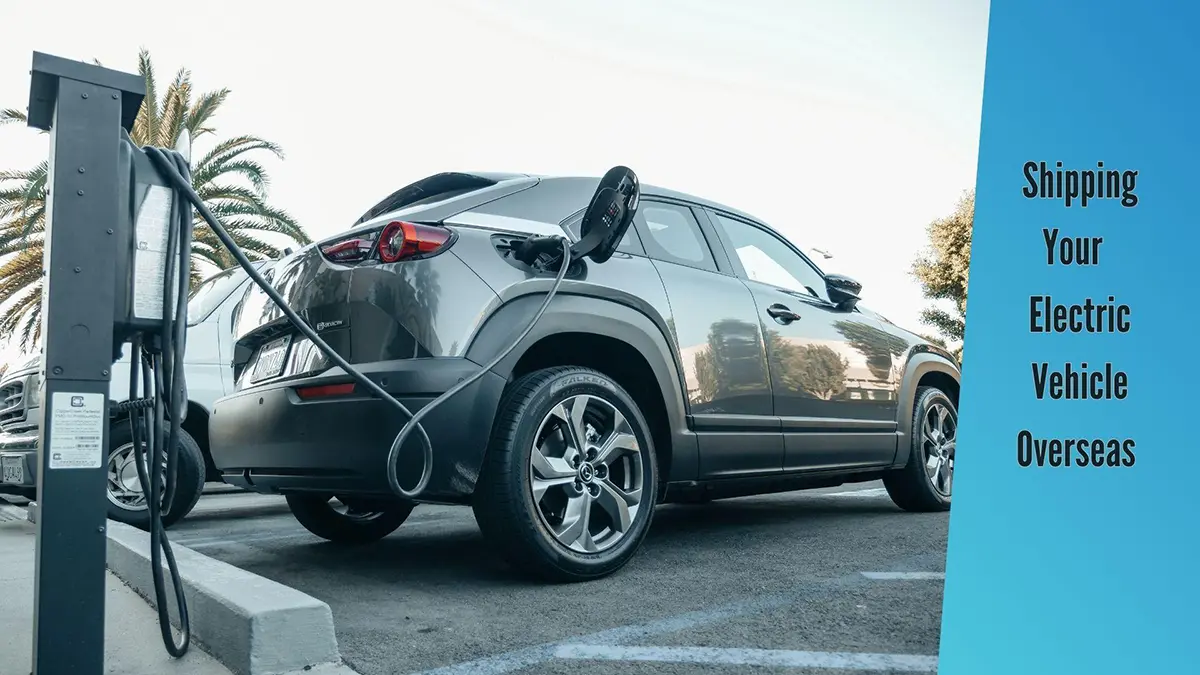You’ve finally decided to join the green revolution, trading in your gas-guzzling beast for a sleek, silent, and environmentally friendly electric vehicle (EV). It is an excellent time to jump on the bandwagon, as the global EV market is expected to hit a whopping $802.81 billion by 2027. The only catch? The EV of your dreams is on the other side of the globe.
Sounds like a conundrum, right?
Don’t fret; we’ll dabble in the nitty-gritty of transporting your electric vehicle internationally, giving you a comprehensive guide that’s as electrifying as the cars themselves. From dealing with the logistics of the paperwork to understanding the cost implications and possible risks involved, we’ve got you covered as the protective bubble wraps around your soon-to-be-shipped electric vehicle. So let’s dive right in:
Is Electric Vehicle Shipping Possible Overseas Without Any Damages?
Shipping electric vehicles (EVs) internationally presents some unique challenges compared to traditional gasoline-powered cars due to the large battery packs and complex drivetrain components. However, with proper planning and specialized shipping processes, it is undoubtedly possible to transport EVs overseas without incurring any damages.
Some key factors that help ensure safe EV shipping include:
- Specialized Cargo Hold Configuration: Ship holds carrying EVs need extra bracing and securement points explicitly designed around the vehicles’ weight distribution and dimensions. The battery packs are weighty and require immobilization during ocean transit. Leading EV shipping providers worked with automakers to develop standardized cargo cell designs for different EV models.
- Temperature & Humidity Control: Lithium-ion batteries can be degraded if exposed to extreme hot or cold, as well as high humidity levels. Ship holds for EVs are climate-controlled to keep temperatures between 20-30°C and humidity below 60%. Thermal blankets help stabilize battery temperatures during loading/unloading in differing climates.
- Battery Disconnection/Isolation: For extra safety, the high-voltage circuits connecting the battery to the electric motor and other components are disconnected during ocean transit. On some models, like the Tesla Model S, the battery pack can be removed entirely from the vehicle and shipped separately using its climate-controlled container if necessary.
- Specialized Personnel Training: Staff handling EV transportation receive extra training over traditional gas vehicle shipping on issues like neutralizing high-voltage components, load securement, and emergency response procedures specific to EVs and their lithium-ion batteries.
Tesla is already shipping thousands of Tesla vehicles from the port of Shanghai to Europe, Asia, and the Middle East.
Shipping Electric Vehicles Overseas - 5 Methods Explained:

Ro-Ro (Roll-on Roll-off)
Ro-Ro ships are vehicle carriers that load and unload by driving vehicles on and off the ship. Vehicles enter the ship via ramps and go directly to the car decks. Tesla has used Ro-Ro shipsextensively to ship vehicles like the Model S and Model 3 from its factory in Shanghai to Europe, the Middle East, and Asia. Advantages are quick loading/unloading times and flexibility to carry different vehicle types. However, cargo space could be more optimized compared to other methods.
Container
EVs can be transported in standard intermodal containers loaded on container ships. This allows stacking containers efficiently using cranes. The advantage is high cargo density and compatibility with intermodal logistics chains. However, vehicles must be properly secured inside containers, which adds complexity. The risk of damage is also higher compared to other methods.
Pure Car Carriers (PCC)
PCCs are specialty ships designed exclusively for carrying passenger vehicles. They have multiple vehicle decks with built-in ramps to load different vehicle types efficiently. Benefits are cargo-optimized design and onboard ramps, allowing quick loading/unloading. However, these vessels cannot carry other cargo, limiting revenue opportunities.
Airplane
For fast long-haul deliveries, EVs can be transported on the main deck of cargo aircraft in secured cages or containers. However, air transport is the most expensive option, up to 10 times the sea freight cost per vehicle. They are used primarily for low-volume premium deliveries rather than mass vehicle transportation.
Land Transport
EVs can be transported over land directly from manufacturing plants near border crossings. The advantage is direct delivery, avoiding transloading, but limited to bordering countries/regions only due to transport costs.
Cost for International Electric Vehicle Shipping:
The international electric vehicle transport costs can range from $800 to $3,000+ depending on factors such as:
- Total distance
- Vehicle size/weight
- Service type (Ro-Ro vs Contianer)
- Import fees and duties
That said, here’s a general idea of the costs of shipping electric vehicles overseas:
| Destination | Roll-ON/Roll-Off |
|---|---|
| United Kingdom | $1,500 |
| New Zealand | $2,800 |
| Melbourne | $3,000 |
| UAE | $2,000 |
| South Africa | $2,200 |
These are just estimated costs for moving electric cars via the Roll-On, Roll-Off method. If you want to move your EV overseas, don’t hesitate to get in touch with us for an exact transport quote for the destination of your choice.
How to Prepare Electric Vehicles for International Transport?
Ensure the Vehicle Meets Safety and Emissions Standards
Review the destination country’s regulations on electric vehicle safety, lighting, markings, etc. Electric vehicles have specific standards that may differ across borders.
Ensure the EV meets UN safety standards like crash tests if it moves on its power during any part of the transport.
Verify the EV meets emissions standards in the destination country. Some places may require testing/certification, even for zero-emission EVs.
Prepare Customs Paperwork Thoroughly
Determine HS product code(s) accurately for the electric vehicle and components. Incorrect codes can lead to penalties or delays.
Gather other required information like value, country of origin, and commercial invoice descriptions. Omitting data can raise red flags.
Classify the EV correctly as permanent import, temporary import, re-import, etc. based on purpose. Customs processes differ.
Obtain an EPA certificate if exporting the EV from the U.S. to prove compliance with air quality standards.
Check Transportation Restrictions
Verify any restrictions on lithium-ion battery size, type, placement, etc., for air/ocean transport. Rules vary.
Check weight and dimension limits for the EV on the intended mode(s) of transport. Oversized items need special handling.
Determine if the EV can/should be shipped with the battery in place or removed. The safest option depends on the battery type.
Evaluate any routes/countries that ban or restrict EV imports specifically. Adjust transit plans accordingly.
Take Safety Precautions with Batteries
Disconnect and isolate the battery using insulated tools per dangerous goods regulations. Prevent accidental activation.
Protect battery terminals from short-circuiting. Use insulating caps or wraps.
Verify the battery is at 30-50% charge for optimal stability. Avoid fully charged or near 0%.
Package lithium-ion batteries properly with anti-vibration, shock-absorbing materials if shipped separately.
Prepare the Vehicle Itself
Clean EVs thoroughly inside and out to ease inspections across borders. Remove or secure loose items.
Check tire pressure and mechanical parts are in good order. Fix or replace as needed.
Deactivate anti-theft devices so the EV can be turned on during transit if required.
Protect vulnerable components like lights, mirrors, and cameras from damage. Use covers, padding, and removal if necessary.
Hire an Expert Transport/Logistics Company
Consider hiring professionals to handle customs, documentation, and shipping coordination and ensure it goes smoothly.
Get insurance in case of damage. International EV transport has complexities and risks.
Paperwork and Regulations For Transporting Electric Cars Internationally:
Alright, so before importing an electric vehicle to another country, there are a few things you’ll want to look into.
- First, check what import laws the destination nation has regarding EVs - some places have rules around emissions that the vehicle needs to meet.
- You’ll also need to gather the necessary paperwork. Things like a commercial invoice showing what’s being imported, a bill of lading from the shipping company, and documentation that the vehicle meets their regulations. It’s a good idea to hire an import professional to guide you through getting all those documents together properly.
- Make sure the vehicle’s title is clear, too, as many countries require that. You can check the title status online using the car’s VIN (Vehicle Identification Number). Typical documents you’ll need for international shipping are your passport, the sale agreement if you bought it overseas, and the title. A shipping company can help collect those.
- Don’t forget there may be additional forms needed once it arrives in port, so look into your destination’s specific guidelines as well. Always check both countries’ rules to make the process go smoothly.
- Some shippers like Maersk have policies around vehicles powered by lithium batteries - EVs and hybrids always need to be declared as dangerous goods. And shippers must comply with IMO regulations for transporting hazardous materials to avoid fees. It’s worthwhile learning about those regulations yourself, too.
- When shipping between countries, the IMDG Code has provisions about battery types and fuel tanks that are important to understand; EVs with lithium batteries always require dangerous goods documents. And paperwork like a declaration and packing certificate are needed if transporting as a hazardous material. (Your transport broker should know this, but it is a good idea if you go through these things as well, just so you are not going into it blindly)
- When shipping cars internationally, it’s crucial to understand the rules about battery types and fuel tanks , as listed in the IMDG Code Special Provision 961. For instance, vehicles powered by lithium batteries always have to be booked as dangerous goods, and conditions apply when vehicles can be exempt from meeting certain conditions of the code.
- Document requirements for shipping as Dangerous Goods include a Dangerous Goods Declaration and a Container Packing Certificate.
- Finally, vehicles are usually shipped in dry cargo containers , but the transporter may specify something different in some cases.
Finding a Reliable Transporter For Moving Electric Vehicles Internationally:
Research specialized transport companies for EVs
There are transport companies that specialize in shipping electric vehicles internationally. Research companies that have experience transporting EVs overseas. They will understand the unique requirements for transporting electric vehicles compared to standard vehicles.
Verify certifications and licenses.
Make sure any potential transporter has all required licenses and certifications to legally transport EVs internationally. They should be registered with organizations like the International Air Transport Association (IATA) and Federal Maritime Commission.
Check that companies have an active FMC license for international ocean transport and are IATA-certified for air freight. This ensures they meet all regulations.
Evaluate their experience with lithium-ion batteries.
Since EVs contain hazardous lithium-ion batteries, ensure prospective transporters have training and experience handling them. They should know proper loading/unloading, storage procedures, plus regulations for transporting lithium batteries.
Ask about their experience transporting EVs with lithium batteries internationally. Check if they provide documentation like shipping declarations required for crossing borders with lithium batteries.
Inquire about temperature-controlled transport options.
Lithium-ion batteries in EVs can be damaged by temperature extremes. Verify the transporter offers temperature-controlled transport solutions to maintain safe battery temps.
Refrigerated containers and climate-controlled spaces with lower temperatures (15 degrees centigrade) are ideal for Lithium Ion batteries. Ensure the company has access to temperature-regulated transport equipment.
Review insurance coverage and liability.
Make sure the transporter has adequate insurance coverage for the full value of the EVs they will be transporting, including coverage for potential battery damage. Get documentation of coverage.
Ask for insurance certificates showing at least $1 million in coverage for the vehicles they will transport. $2 million or more is preferable.
Get references from past EV transport customers.
Reputable companies should be able to provide references from previous customers who had EVs shipped internationally. Speaking to their past clients provides valuable insights.
Contact the references and ask about their experience having EVs shipped, the transporter’s handling of batteries, and any damages or issues.
Frequently Asked Questions:
Should I Drain The Battery of my Electric Vehicle Before Transport?
No, you shouldn’t. Draining the battery entirely could potentially harm it. However, it’s recommended to reduce the charge to around 50% to prevent any possible damage during the shipping process.
Should I Disconnect The Battery When Shipping Electric Vehicle Overseas?
Disconnecting the battery isn’t usually necessary. Most shipping companies have procedures to handle electric vehicles properly. But always check with your shipping agent for their specific guidelines.
How to Protect My Electric Vehicle Battery When Shipping Overseas?
Protection is all about preparation! Ensure your electric vehicle is charged to about 50%, as mentioned above. Use a protective cover if possible. Also, verify that the shipping company is experienced in handling electric vehicles to avoid any mishaps.
How Long can an EV sit without Being Driven?
Electric vehicles can sit without being driven for about two weeks without losing significant battery charge. However, leaving your EV idle for longer periods could result in battery discharge.
What Drains an Electric Vehicle Battery the Most?
Air conditioning, fast acceleration, and maintaining high speeds are the top three factors that drain electric vehicle batteries the most.
Can I Ship My Tesla?
Absolutely, you can! Tesla cars are shipped overseas quite regularly. You’ll just need to find a reliable and reputable auto shipping company that handles electric vehicles.
How do I Ship an EV Battery?
Shipping an EV battery separately requires special handling due to its classification as a dangerous good. You’ll need a shipping company experienced in dangerous goods shipping. They’ll ensure it’s packaged correctly and follows all safety regulations.
How Much Does it Cost to Ship a Tesla Across the Country?
The cost depends on factors such as distance, shipping method, and the specific model of your Tesla. On average, the cost could range from $1,000 to $3,000.
Does FedEx Accept Lithium Batteries?
Yes, FedEx does accept lithium batteries, but there are regulations and guidelines to follow. You must declare them as dangerous goods and package them carefully according to the FedEx guidelines.





